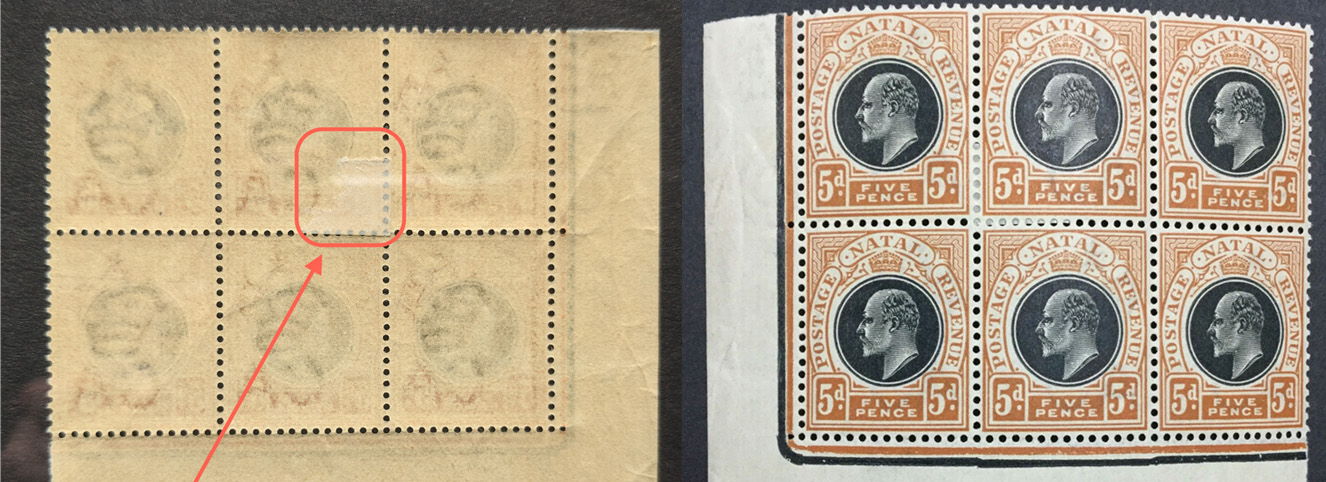- Published on
The thing about unhinged stamps
Before the 1950s collectors used stamp hinges to attach stamps to album pages.
 |
|---|
| Remnant of a stamp hinge attached to a block of KEVII stamps printed in 1902. |
Stamp hinges were the way to organize a collection. They were so commonplace that no one thought twice about preserving the untouched condition of a stamp's behind. Everyone did it, and all agreed it didn't make any difference to a stamp's collectible value. After all, a collector might have put the hinge in the ample margins of the stamp block above if they believed otherwise.
Perhaps the real reason for indifference was the absence of cost-effective alternatives. Glassine envelopes existed, but they are poor at showcasing collections. Plastic sleeves did not exist. Until they did. Sentiment changed, and pristine unhinged stamps became the highest grade of stamp condition. Along with it came a new and particular kind of collectibility.
To be clear, Mint Never Hinged (MNH) condition stamps are not necessarily more valuable than, say, used stamps. Value depends on many things, in context. But when we're talking about a multiyear effort to showcase the best of 1900s KEVII stamps as art, only the best will do (I assert). Hinges and their remnants are ugly, simply put. Even if they're tucked away behind a stamp, there's a kind of discomfort in knowing the truth.

Stamp hinges and their remnants are a blight on stamps, change my mind.
Now, stamps of the 1900s era like KEVIIs are difficult to find in mint unhinged condition. So much so that many stamp catalogs don't make a distinction—valuations for stamps in "mint condition" assume that hinges are basically a given, and require merely that the stamps are unused, being hinged or previously hinged. Accurate MNH valuations are up to market value, for that matter. Suffice to say, the vast majority of collectors bought and exchanged singles, and it's extremely rare that individual stamps escaped hinge-taint.
How then to secure pristine condition individual stamps for an exacting drawing project? There is a simple and rather incidental answer, if you can stomach it.
When avid collectors bought larger stamp pieces in blocks, hinges would naturally (and obviously) only cover the back of some stamps, leaving others untouched. Margins on blocks or sheets might also incidentally fall victim to hinges, sparing the stamps themselves.

A block of four stamps, the top row affixed with hinge, the bottom row is untouched.
At this point a 5 year old could tell you what to do. Simply tear off the clean stamps, and you have clean singles. Conveniently, there's even some perforation to make the job easier. Collectors would say no. Larger intact pieces are valued higher, more than the sum of their parts. Separation instantly devalues the piece. Especially stuff from the early 1900s. Why break up a fabric of history, something that's been holding on for over a hundred years?
I've been collecting Natal KEVII stamp blocks for a while, and they're not easy to come by. Over time I developed a higher vision for exhibiting these stamps, these miniature masterpieces. Would separating off unhinged stamps really devalue things, or create an opportunity for greater appreciation? I succumbed to the 5 year old inside me.
All pieces in the KEVII project (except one) feature a truly mint stamp separated from a larger block. That's the thing about these unhinged stamps. Each piece is meant to truly capture a unique journey of inked paper through time.
Notes